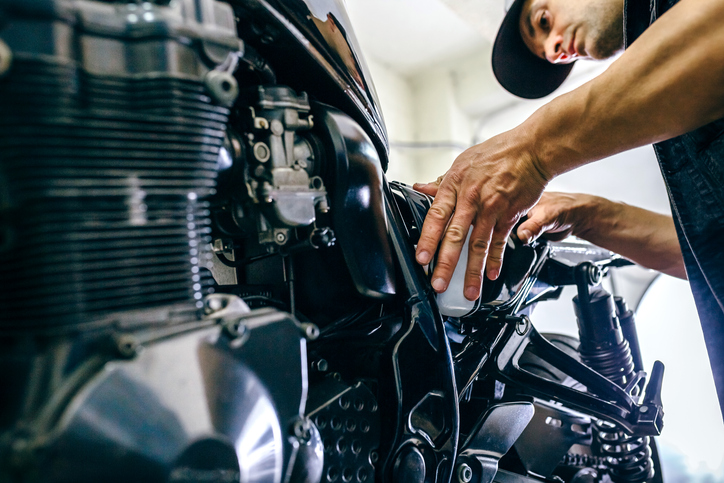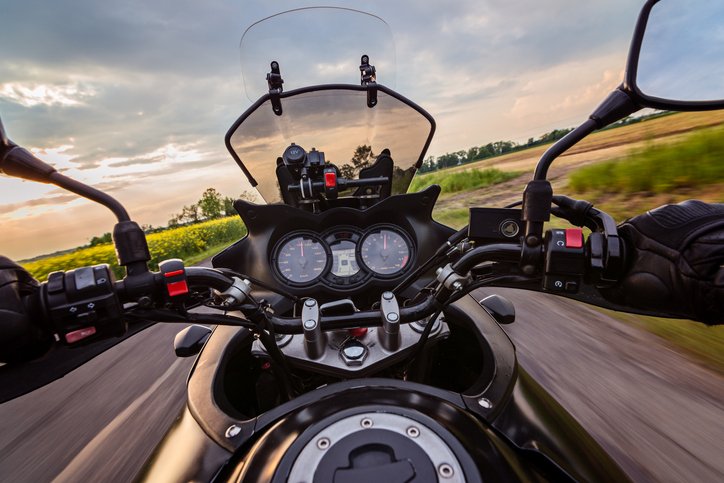
Winter can be hard on bike and rider, with wet roads and cold conditions putting an increased strain on parts, fluids and components. But, there are things you can do to prepare you and your motorcycle for the cold, wet weather, and our guide on preparing your motorbike for winter has practical tips to help you get ready for the coming season.
Navigation
Preparing Your Motorcycle for Winter Riding
Coolant/Antifreeze
Because it’s hard to know the ratio of water and antifreeze in your bike’s cooling system, it’s important to check and refill it before winter, to make sure your bike’s engine is protected from freezing temperatures.
Start by doing a visual check of the coolant/antifreeze reservoir – is the liquid up to the fill line and does it look clear and free from particles? You can also get testers which let you check the winter protection of the fluid. This will help you make a decision on whether you need to flush and refill the system.
What coolant/antifreeze can I use in my motorbike?
If you decide to refill, choose a quality coolant/antifreeze. Prestone Coolant/Antifreeze is safe to use in motorbikes and will protect your engine down to -37°C, so you know your bike will be protected in extreme cold weather. It’s available as both from-concentrate and ready-to-use formulas; we recommend distilled water when using from-concentrate.

Oil
Some motorcycle engine oils aren’t suitable for winter conditions; they can thicken in low temperatures, causing problems and putting pressure on moving parts in the engine. Make sure you choose an oil which has a winter temperature rating, so that it retains its viscosity whatever the weather.
If your bike has a four-stroke engine, you should change the filter at the same time that you change the oil. We’d definitely recommend flushing and refilling your oil in time for winter, particularly if you aren’t sure that what’s in there at the moment is winter-ready.
Battery and Electricals
Just like with a standard car battery, motorcycle batteries and their associated electrical systems are prone to faults in winter. That’s because cold temperatures affect how much charge batteries generate and how well they’re able to hold power. One of the leading causes of breakdowns for motorbikes in the winter is a flat battery, so it’s vital that you check and maintain yours before the cold weather hits.
Inspect and clean your bike’s battery, making sure that the terminals are free from dirt and residue which could hamper their performance. We’d recommend checking the charge on the unit with a voltage meter, and using a trickle charger to give it a boost when you aren’t riding. Alternatively, if your battery is old or showing signs of fault, it could be worth fitting a new one.
Lubricating Moving Parts
Moving parts on your bike can easily be affected by winter riding conditions. Rain, hail, salt and dirt can interfere with lots of components, which is why you should regularly clean, maintain and lubricate your motorcycle in the winter months.
Use a good-quality lubricant to treat exposed parts; we’d recommend doing this after every wet-weather ride to keep exposed parts free from rust and residue. Make sure you spray parts like the twist grips too, as these can suffer like any other part of your bike.

Tyre Maintenance
It goes without saying that winter can make riding conditions more hazardous, with decreased grip being just one of the problems that motorcyclists face in the colder months. The condition and pressure of your tyres is crucial to safe riding in the winter; you need plenty of grip to maximise your hold on the tarmac in wet and slippery conditions.
Don’t make the mistake of deflating your tyres to increase their profile and get more grip on the road. This trick doesn’t work, and it will only make you more likely to get a puncture. Actually, the round profile of a fully pumped up bike tyre is a good thing in wet riding conditions, as it reduces your risk of aquaplaning.
Suspension
If your bike has suspension adjustment, it could be worth playing around with the settings to gain a more reliable setup ahead of winter riding conditions. Adjusting the damping and compression of the suspension can make motorcycles more responsive and balanced in wet, slippery conditions, but don’t change things too drastically. You should also make a note of the original setup, so you can return to it if you don’t like how the bike feels after you’ve made changes.
Lights
Not convinced by your current light setup? You need all the visibility you can get now that the dark nights are on their way, so consider some different options if you’re struggling to see the road ahead.
You have a couple of options when it comes to upgrading motorcycle bike lights: changing the bulbs for more powerful ones or fitting supplementary lights to the handlebars which can improve your visibility, particularly in foggy weather.
Things to Consider for Safe Riding in the Winter

Protect Your Hands
One of the worst things about riding a motorbike in winter is living with cold hands. Your hands are just about the most exposed area when riding, and it can be hard to keep them warm, even when wearing good quality motorcycling gloves.
Fitting aftermarket hand covers, which go over the twist grips and brake/clutch levers, can help to keep wind off your hands. You can also buy a bar-mounted heating element, which warms the grips as you ride, keeping your hands nice and toasty in even the worst of the winter weather.
Wear Layers of Clothing
Dressing for winter riding can be a steep learning curve for new motorcyclists. It’s all about wearing layers that cover your entire body, leaving no gaps for cold air to get under your leathers and leave you shivering at the handlebars.
Start with a close-fitting base layer, like long johns and a fitted, long-sleeved thermal shirt. Then add extra layers, but make sure they don’t reduce your range of movement. Remember to wear something to keep your neck warm too, as this can be easily exposed out on the road.
Prevent Your Visor from Misting When It’s Cold
One of the bugbears of riding a motorbike in the winter is the ease at which visors can fog up in the cold – it’s both annoying and dangerous. There are a few things you can do to stop this happening, including:
- Wear a neck warmer that covers your nose and mouth. This will direct air away from the visor, reducing the likelihood of condensation inside your helmet.
- Use anti-fog wipes. These coat the inside of your visor with a solution which stops misting. You can also buy sprays which do the same thing, but wipes are convenient enough to slip in your pocket.
- Use a self-adhesive anti-fog skin, which sticks on to the inside of your visor to stop it misting. This is the most expensive option.

Get Breakdown Cover
Breakdowns are more common in winter, so if you’ve been putting off getting breakdown cover throughout the warm, dry summer months, now’s the time to invest. No one wants to be stranded at the roadside with a faulty bike on a dark, wintry night, so breakdown cover is a small price to pay for peace of mind.
At Prestone, our high-performance maintenance fluids are tested in all extremes, so you can get your bike ready for whatever winter throws your way. To find out more, visit our homepage.
